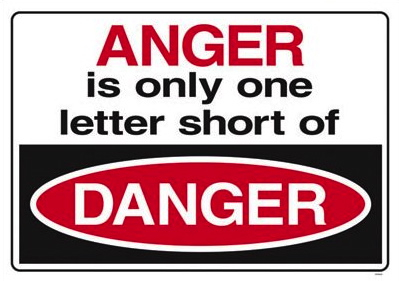Meditate on Anger…to Set it Free!
Think about the following:
- Has anyone or any situation ever made you so angry that you felt like you’d lost control of your emotions and were a complete victim to your anger?
- Have you ever felt so angry, that while you were in your anger, you were completely unable to remove yourself from that state of mind…even though you knew better?
- Have you ever had an outburst of anger, only to realize later that you’d hurt someone who you cared about or who mattered to you?
What would you do if I told you that revisiting one of these events was a way to work with your mind? What if I said that you could actually meditate in a state of anger to learn how to loosen its hold on your mind? Does that sound impossible or difficult? Actually, that’s exactly what I’m going to show you how to do.
Getting Distracted in Anger is What Makes it So Dangerous
Anger by itself isn’t dangerous, it’s not even bad. Handled by a mind that’s capable of remaining stable when it arises, anger is like any other emotion; it comes, and then goes.
What makes it dangerous is that for so many of us, when we get angry, we get lost in it. We lose our focus, lose our mind(fulness) and get swept away by this very powerful emotion.
For me, and maybe for you too, I can be in the middle of an angry episode, and even though I know that I’ve lost my footing, I’m so consumed by the moment, that I forget that my anger isn’t “real” in a sense. That is, if I just allow it to, it will dissipate and, given enough time, I’ll be able to regain my stability.
For most people, the danger of anger is the feeling of being lost in it, “losing touch” with the present. The intensity and power of anger is its ability to cause us to completely get distracted from the moment and swept up into the fear and anxiety of the emotion.
If we weren’t so distracted by our anger and the fear that accompanies it, would we be able to work with it?
Meditation is About Non-distraction
At its heart, meditation is a state of non-distraction. In meditation, we learn how to become less distracted by our thoughts and emotions, and how to stay in the present, aware of the moment.
Meditation teaches us to be with whatever is in the present, without getting lost in our thoughts, feelings, emotions, and sensations (for more on this, check out the FREE ebook on this site, How to Work with the Four Distractions). That’s the beauty of meditation.
With meditation, we can take even the strongest emotions, like fear and anger, and learn how to remain present with them, undistracted by their power.
Imagine if you could prevent yourself from getting lost in your anger by being able to stay focused, in the moment, and aware of what you were feeling and how you were acting.
Being Present With Your Anger
When you encounter a situation that makes you angry, what is it that prevents you from maintaining a calm mind? Could it be that you’re getting distracted by your anger, or that fear of the moment has caused you to lapse into your usual habits of how you deal with things. What if you were able to remain undistracted?
Getting out of our patterns, especially ones that are strong like how we deal with anger, take practice.
Practice Getting Angry
I’m not sure about you, but I know that when I’m really in the middle of something that demands my complete attention and focus, if I’ve never been in the situation before, it can be a little unnerving. In fact, I can feel completely lost and want to run away. That feeling usually comes from being fearful or distracted; something about the situation has caused me to get frightened or distracted and has caused me to forget how to be in the moment with whatever is going on.
Like anything that’s new, working with anger takes practice. As we become familiar with not reacting to this strong emotion, we become less fearful and distracted by it.
In the following exercise, based on an exercise from my book, Minding the Bedside: Nursing from the Heart of the Awakened Mind, and available as a downloadable PDF here, and as an audio file here, you’re going to practice working with anger.
This exercise isn’t an instant “fix it,” it’s not going to magically make all of your anger go away, or take away the fear that can accompany anger. What it will do is to give you a tool to begin to work with anger and learn more about how you react to this strong emotion. It will also help you to see, and this is important, how impermanent and intangible emotions are, even anger.
In this exercise, remember that whatever you’re feeling is impermanent and that you’re the one responsible for bringing the feelings and thoughts into the present and can just as easily let them go.
If you haven’t yet begun a meditation practice, or learned how to work with your breath as an anchor for your attention, you can go here to get scripts for doing so. It’s best to have some practice in doing so first before you begin this exercise.
So, let’s begin:
Find a comfortable position to be in, even for a few minutes, where you can be undistracted and as relaxed as possible. When we begin to meditate, we use our breath as an anchor of our attention. Why the breath? It’s always there, it’s easy to focus on, and by watching our breath we calm our mind.
Start by briefly watching your breath, bringing your attention back to the breath when you become distracted. Again, if you aren’t experienced in working with the breath in meditation, use the scrpt probided above and here.
Because we’re working with anger, this exercise may stir up some uncomfortable emotions; it’s meant to. Just be with whatever arises, as you have learned to be with the different thoughts that arise within your mind.
After finding some stability within your mind using the breath as an anchor, think back to a time when you felt a strong feeling of anger. Do this in a gentle manner at first, letting the feeling arise slowly. If it becomes too much at any time, let it go and come back to the breath. Take some time to remember an incident or time when strong emotions were present and when you felt swept away or affected by them.
Now, as vividly as possible, open up more and let this memory flood your body and your mind. Feel the feelings; let the physiology of the moment enter you to a level that feels like you can be with it and deal with it.
Feel what it felt like when you were angry. Be with the feelings. Be with the emotions. Remember, become keenly aware that all of this is happening in your mind, nowhere else. In a way, really “get into” this exercise by drawing the emotions that you felt into the present and seeing how dramatically you can affect your present state of mind and body without getting lost in the thoughts and emotions!
Remain with this exercise for as long as you’re comfortable doing so. Return to the breath if you become distracted. Return to the remembrance of your compassionate nature if you get stuck in the emotions. Return to a realization that everything is transient, temporary, almost illusory and that anything that you may be feeling at present is without substance. Stay with the exercise for a few minutes.
And then, just relax in the vividness of this moment, dropping all methods, allowing the thoughts to move through your mind without grasping after or following them.
What this exercise and exercises like this do is to give you practice in working with strong emotions. It’s really amazing, but you can take a past incident, and get just as riled up over it now as you were when it first happened. And it’s a great way to work with the emotions without being in the middle of whatever it was that originally caused it!
I go over this a great deal in my book because I feel that it’s necessary to gain experience in working with strong emotions before having to do it in your daily life. Learning how to work skillfully with anger takes practice and you probably want to have some time practicing before trying it “in real life.”
Another great thing about doing this kind of exercise is that you get a feel for how “unreal” these kinds of feelings are. I mean, think about this: we can get ourselves physically riled up over things that happened years ago. Seriously, how real is that? Yet that’s the kind of power that emotions like anger have over us.
Meditation Helps You to Find Patience in Anger
However you learn to deal with it, having patience when you do get angry is the key to learning how to work with this strong emotion. There are reasons why so many crimes are committed “in fits of anger and passion,” and why so many of us – myself included – have obstacles around dealing with anger when it arises.
Patience is necessary because, just like trying to put out fire with gasoline, if we greet our anger with more anger over having gotten angry, it only makes it worse.
As soon as you can recognize that you’ve lost your temper and have succumbed to your anger, bring the art of patience to the moment and see if it helps. And how do you develop patience? You know what I’m going to say, right?
Meditation is an awesome way to develop patience, not only with yourself, but with others as well. When you begin to meditate, all sorts of obstacles (all created by your very own mind) will arise. Working with these obstacles will generate within you a wellspring of patience. Obviously, this may take time. But it’s worth it! It will allow you to tame the anger within your mind, and that’s great!
By the way, for those of you who like to read about research in meditation and, specifically how anger and emotions can be regulated with meditative practices, check out this link to the PubMed site for articles on meditation and anger management. Enjoy!
Resources for Working with Your Emotions
If this post was helpful to you, here’s another post that I wrote titled, “Why Meditate? Are You Tired of Being Angry, Sad, Jealous or…Exhausted?” Check it out.
Specific to what we’ve discussed here is the free ebook, How To Work With the Four Distractions. Download it and give it a read. I hope that it helps.
Meditation Resources
Here are a few items that can help you to meditate whether you’re a beginner or already have a practice. All of these resources are aimed at helping you in your meditation practice and to do so with less effort and more success. Please let me know what else you need, that’s what I’m here for.
MEDITATION POSTS:
- What is Meditation? Sometimes It’s About Failure
- How to Meditate: Distraction in Meditation Doesn’t Matter
- Meditation Tip of the Week: Stop Meditating
- Meditation Tip of the Week: Meditate…Even When it Doesn’t Work
- How to Meditate: The Most Important Practice…Plus One Great Tip
MEDITATION AUDIO DOWNLOADS:
- Riding the Breath With the Mind
- Beginning With Your Thoughts
- Working With Our Thoughts (more advanced)
This site has tons of tools for learning how to meditate and be compassionate.
I encourage you to look through the HUNDREDS of articles that I’ve written and especially check out my weekly meditation tips and other useful meditation materials provided for your health and well being. Please let me know if you’d like to discuss anything with me, have any questions or need clarification regarding anything that I’ve written about.


